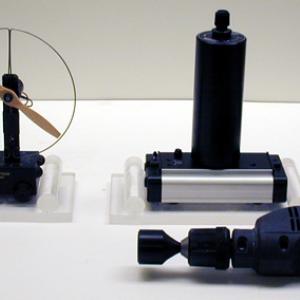College of Liberal Arts & Sciences
2C20.80 - Magnus Effect - Flettner Rotator
Spin the cylinder up to 2500 rpm using the drill and adapter. Blowing air across the cylinder at 90 degrees will cause the cart with the cylinder to move left or right.
- David Kagan, "A Very Inexpensive Magnus Force Demonstrator", TPT, Vol. 48, # 7, Oct. 2010, p. 488.
- Thomas B. Greenslade, Jr., "A Forgotten Magnus-Effect Demonstration", TPT, Vol. 9, #1, Jan. 1971, p. 43. Reprinted: TPT, Vol. 44, #8, Nov. 2006, p. 552.
- A. B. Murphy, "Comment on 'A Flettner Rotor Ship Demonstration'", AJP, Vol. 57, #2, Feb. 1989, p. 181.
- George Barnes, "A Flettner Rotor Ship Demonstration", AJP, Vol. 55, #11, Nov. 1987, p. 1040.
- Bill Franklin, "The Forces on a Rotating Object in Flowing Air", Teaching About Impulse and Momentum, p. 4.20.
- Bill Franklin, "Rotating Sail Magnus Effect Demonstrator", Teaching About Impulse and Momentum, p. 4.19.
- Bill Franklin, "Curve Balls", Teaching About Impulse and Momentum, p. 2.14.
- Jearl Walker, "2.145, Flettner's Ship", The Flying Circus of Physics Ed. 2, p. 143.
- Christopher P. Jargodzki and Franklin Potter, "115, The Flettner Rotor Ship", Mad About Physics. p. 44, 187.
- Neil A. Downie, "22, Rotarudder", Vacuum Bazookas, Electric Rainbow Jelly and 27 Other Saturday Science Projects, p. 182.
- Lizzie Schiffman, "Second Wind", Popular Science, Feb. 2011, p. 96.
- Bill Franklin, "Advance Laboratory or Lecture Demonstration AND Low-Cost Rotating Sail Magnus Effect Demonstrator".
- This Month in Physics History, "March 29, 1959: Lyman Briggs Publishes Research Results on Spin of a Baseball", APS News, Vol. 28, #3, Mar. 2019, p. 2, 3.
Disclaimer: These demonstrations are provided only for illustrative use by persons affiliated with The University of Iowa and only under the direction of a trained instructor or physicist. The University of Iowa is not responsible for demonstrations performed by those using their own equipment or who choose to use this reference material for their own purpose. The demonstrations included here are within the public domain and can be found in materials contained in libraries, bookstores, and through electronic sources. Performing all or any portion of any of these demonstrations, with or without revisions not depicted here entails inherent risks. These risks include, without limitation, bodily injury (and possibly death), including risks to health that may be temporary or permanent and that may exacerbate a pre-existing medical condition; and property loss or damage. Anyone performing any part of these demonstrations, even with revisions, knowingly and voluntarily assumes all risks associated with them.
